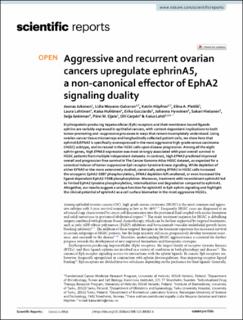| dc.contributor.author | Jukonen, Joonas | |
| dc.contributor.author | Moyano-Galceran, Lidia | |
| dc.contributor.author | Höpfner, Katrin | |
| dc.contributor.author | Pietilä, Elina A. | |
| dc.contributor.author | Lehtinen, Laura | |
| dc.contributor.author | Huhtinen, Kaisa | |
| dc.contributor.author | Gucciardo, Erika | |
| dc.contributor.author | Hynninen, Johanna | |
| dc.contributor.author | Hietanen, Sakari | |
| dc.contributor.author | Grénman, Seija | |
| dc.contributor.author | Ojala, Päivi M. | |
| dc.contributor.author | Carpén, Olli | |
| dc.contributor.author | Lehti, Kaisa | |
| dc.date.accessioned | 2023-01-16T12:01:38Z | |
| dc.date.available | 2023-01-16T12:01:38Z | |
| dc.date.created | 2021-12-02T09:08:59Z | |
| dc.date.issued | 2021 | |
| dc.identifier.citation | Scientific Reports. 2021, 11 (1), . | en_US |
| dc.identifier.issn | 2045-2322 | |
| dc.identifier.uri | https://hdl.handle.net/11250/3043689 | |
| dc.description.abstract | Erythropoietin producing hepatocellular (Eph) receptors and their membrane-bound ligands ephrins are variably expressed in epithelial cancers, with context-dependent implications to both tumor-promoting and -suppressive processes in ways that remain incompletely understood. Using ovarian cancer tissue microarrays and longitudinally collected patient cells, we show here that ephrinA5/EFNA5 is specifically overexpressed in the most aggressive high-grade serous carcinoma (HGSC) subtype, and increased in the HGSC cells upon disease progression. Among all the eight ephrin genes, high EFNA5 expression was most strongly associated with poor overall survival in HGSC patients from multiple independent datasets. In contrast, high EFNA3 predicted improved overall and progression-free survival in The Cancer Genome Atlas HGSC dataset, as expected for a canonical inducer of tumor-suppressive Eph receptor tyrosine kinase signaling. While depletion of either EFNA5 or the more extensively studied, canonically acting EFNA1 in HGSC cells increased the oncogenic EphA2-S897 phosphorylation, EFNA5 depletion left unaltered, or even increased the ligand-dependent EphA2-Y588 phosphorylation. Moreover, treatment with recombinant ephrinA5 led to limited EphA2 tyrosine phosphorylation, internalization and degradation compared to ephrinA1. Altogether, our results suggest a unique function for ephrinA5 in Eph-ephrin signaling and highlight the clinical potential of ephrinA5 as a cell surface biomarker in the most aggressive HGSCs. | en_US |
| dc.language.iso | eng | en_US |
| dc.publisher | Nature Research | en_US |
| dc.rights | Navngivelse 4.0 Internasjonal | * |
| dc.rights.uri | http://creativecommons.org/licenses/by/4.0/deed.no | * |
| dc.title | Aggressive and recurrent ovarian cancers upregulate ephrinA5, a non-canonical effector of EphA2 signaling duality | en_US |
| dc.title.alternative | Aggressive and recurrent ovarian cancers upregulate ephrinA5, a non-canonical effector of EphA2 signaling duality | en_US |
| dc.type | Peer reviewed | en_US |
| dc.type | Journal article | en_US |
| dc.description.version | publishedVersion | en_US |
| dc.source.pagenumber | 0 | en_US |
| dc.source.volume | 11 | en_US |
| dc.source.journal | Scientific Reports | en_US |
| dc.source.issue | 1 | en_US |
| dc.identifier.doi | 10.1038/s41598-021-88382-6 | |
| dc.identifier.cristin | 1963117 | |
| cristin.ispublished | true | |
| cristin.fulltext | original | |
| cristin.qualitycode | 1 | |

